PR
X
Keyword Search
▼キーワード検索
Comments
続日本100名城東北の…
New!
オジン0523さん
2025年版・岡山大学… New!
隠居人はせじぃさん
New!
隠居人はせじぃさん
【甥のステント挿入… Gママさん
Gママさん
ムベの実を開くコツ… noahnoahnoahさん
noahnoahnoahさん
エコハウスにようこそ ecologicianさん
2025年版・岡山大学…
 New!
隠居人はせじぃさん
New!
隠居人はせじぃさん【甥のステント挿入…
 Gママさん
Gママさんムベの実を開くコツ…
 noahnoahnoahさん
noahnoahnoahさんエコハウスにようこそ ecologicianさん
Calendar
カテゴリ: 海外旅行
北側壁面にある窓のひとつ
、祭壇に向かって左手側(聖歌隊席の北側)に位置。
この「磔刑とキリストの栄光」の構図は、内陣側面窓の伝統的配置テーマのひとつで、
祭壇背後(東端)ではなく側面に置かれる場合が多い と。
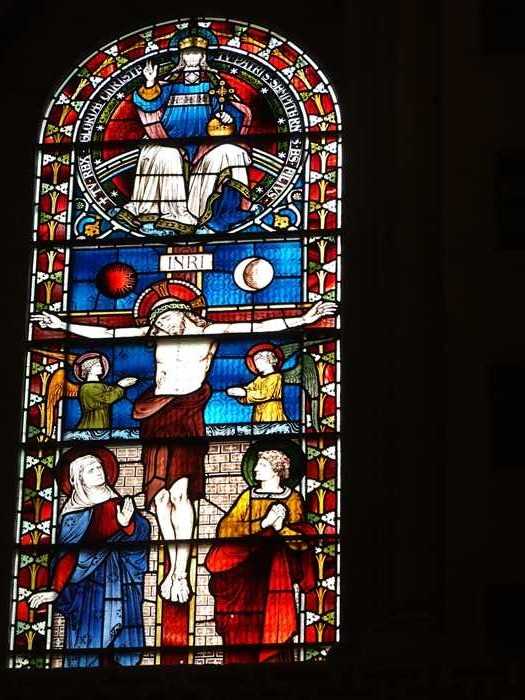
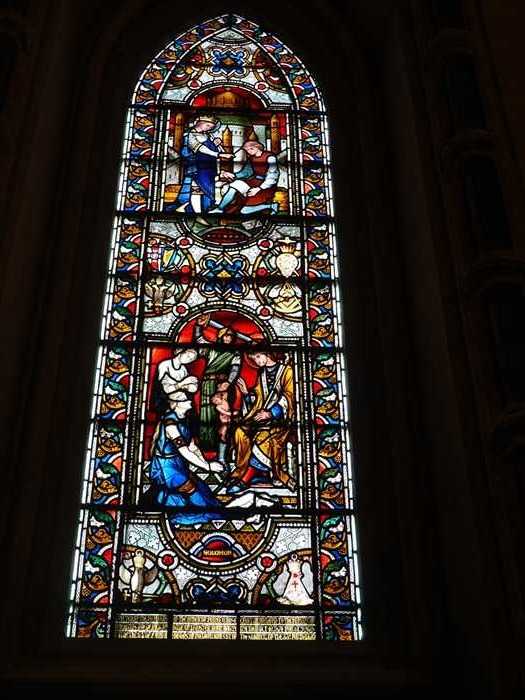
上段をズーム して。

これも身廊、南側通路、南、東から2番目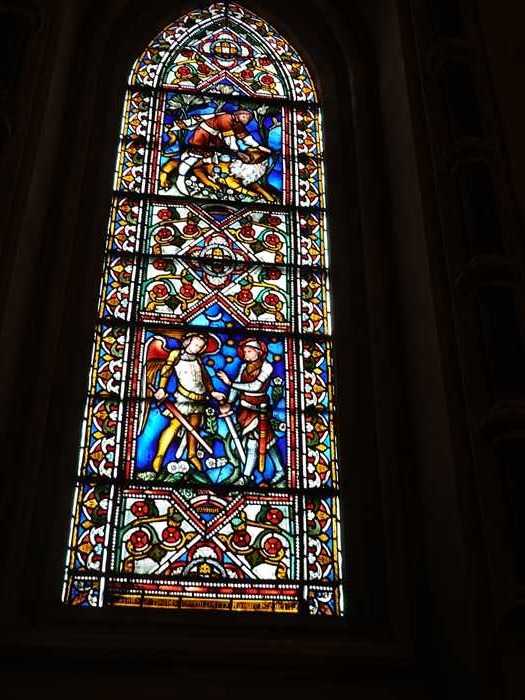
これも身廊、南側通路、南、東から3番目
下段にオルガンや楽器を弾く人物(おそらく詩篇作曲者ダビデや聖セシリア)が描かれ、
南列の旧約音楽主題と一致。
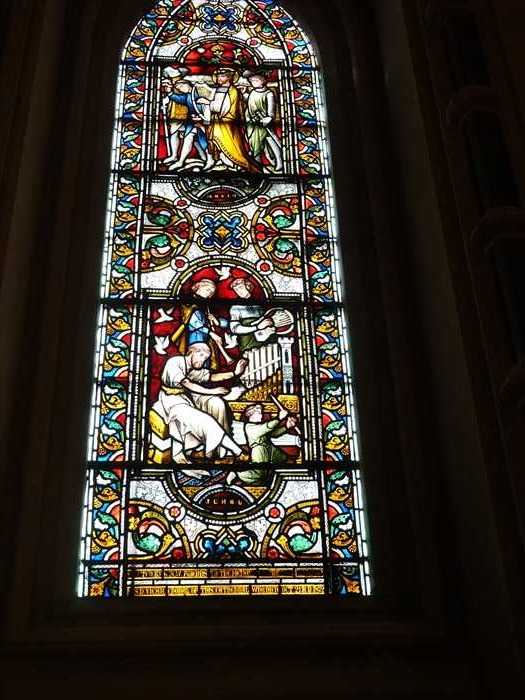
中、下段をズームして。
中央の人物
白い長衣をまとい、座って鍵盤を弾く人物。聖書や伝統美術においては、 ユバル(Jubal)(創世記4:21)とされることが多い。
ユバルは旧約聖書で「竪琴と笛を奏でる者の祖」とされ、楽器製作や音楽の起源を象徴する と。

内陣南側(右側)の西寄り、聖人列(特に天使・守護聖人テーマ)の並びの中に。
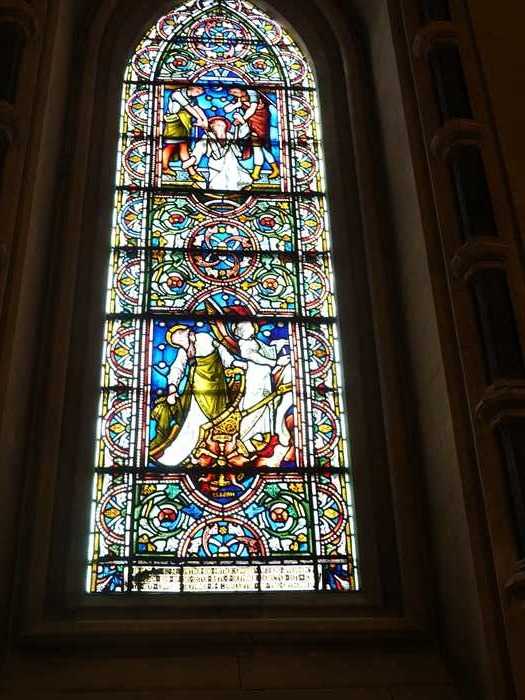
南面のステンドグラス案内図。

南側入口付近(南側通路の西端) にあるステンドグラス。
南側通路の最も西寄り、観光案内や掲示板が設置されているエリア上部に位置。
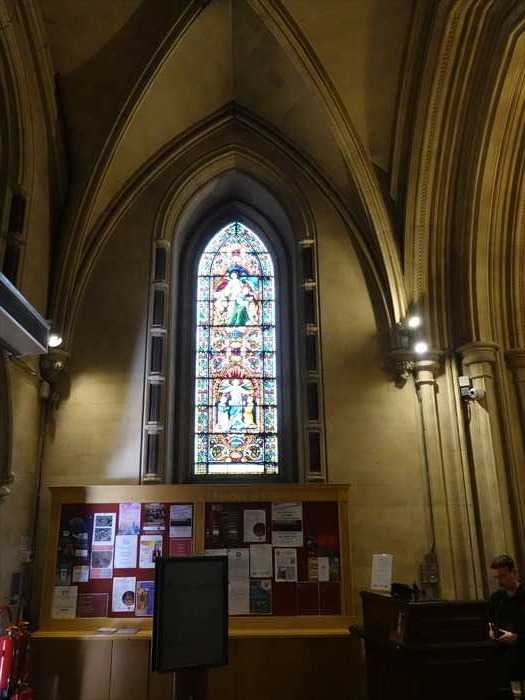
この窓のモチーフは、 上下2段構成で聖人像が描かれており 、南列の物語順には含まれず
独立した装飾的・記念的窓となっている と。
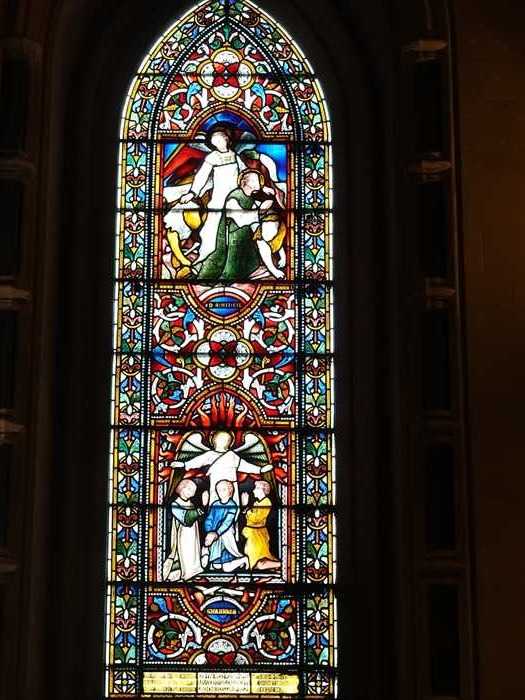
上段をズームして。
「ダニエル書」に描かれるダニエルが獅子の穴から救われる場面。
伏すライオンが描かれている。
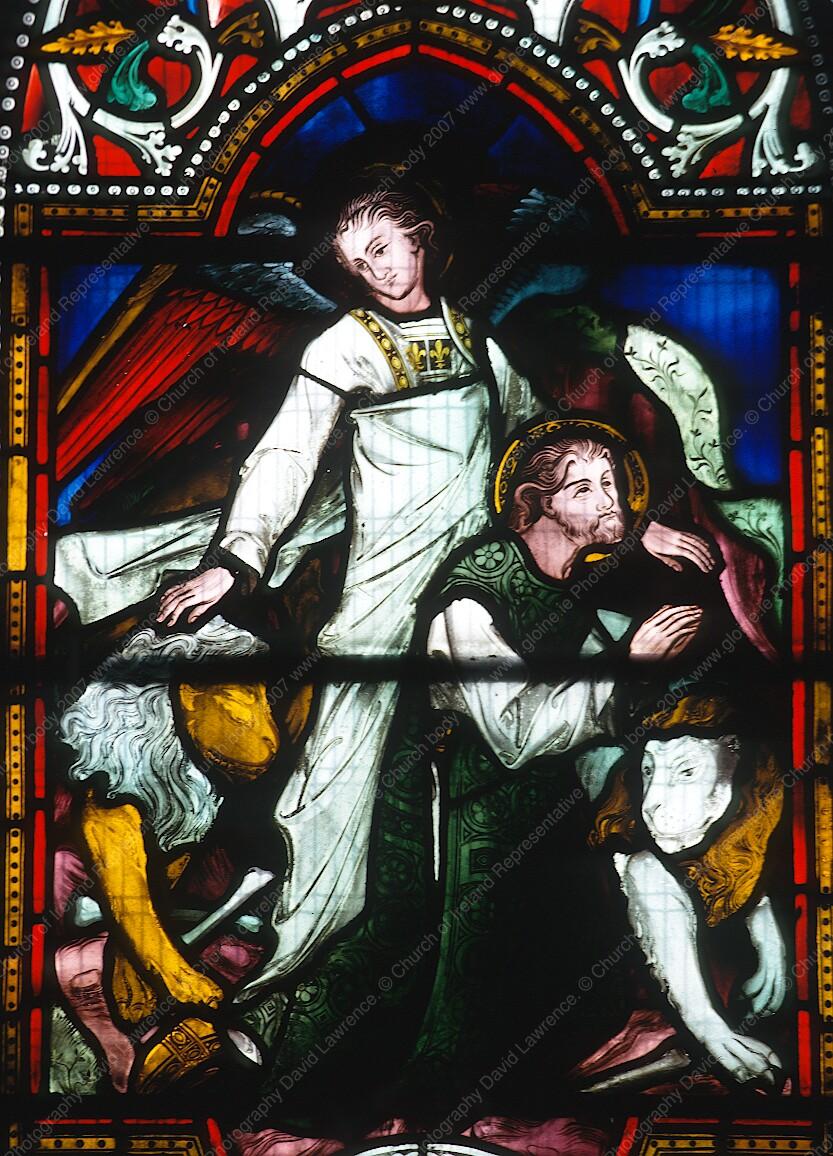
下段をズームして。
火の炉の中の三人の若者(シャデラク、メシャク、アベド・ネゴ)と彼らを守る天使を描いている。
背景の炎と天使の翼が象徴的で、彼らが火の中でも無傷で守られた奇跡を表す。
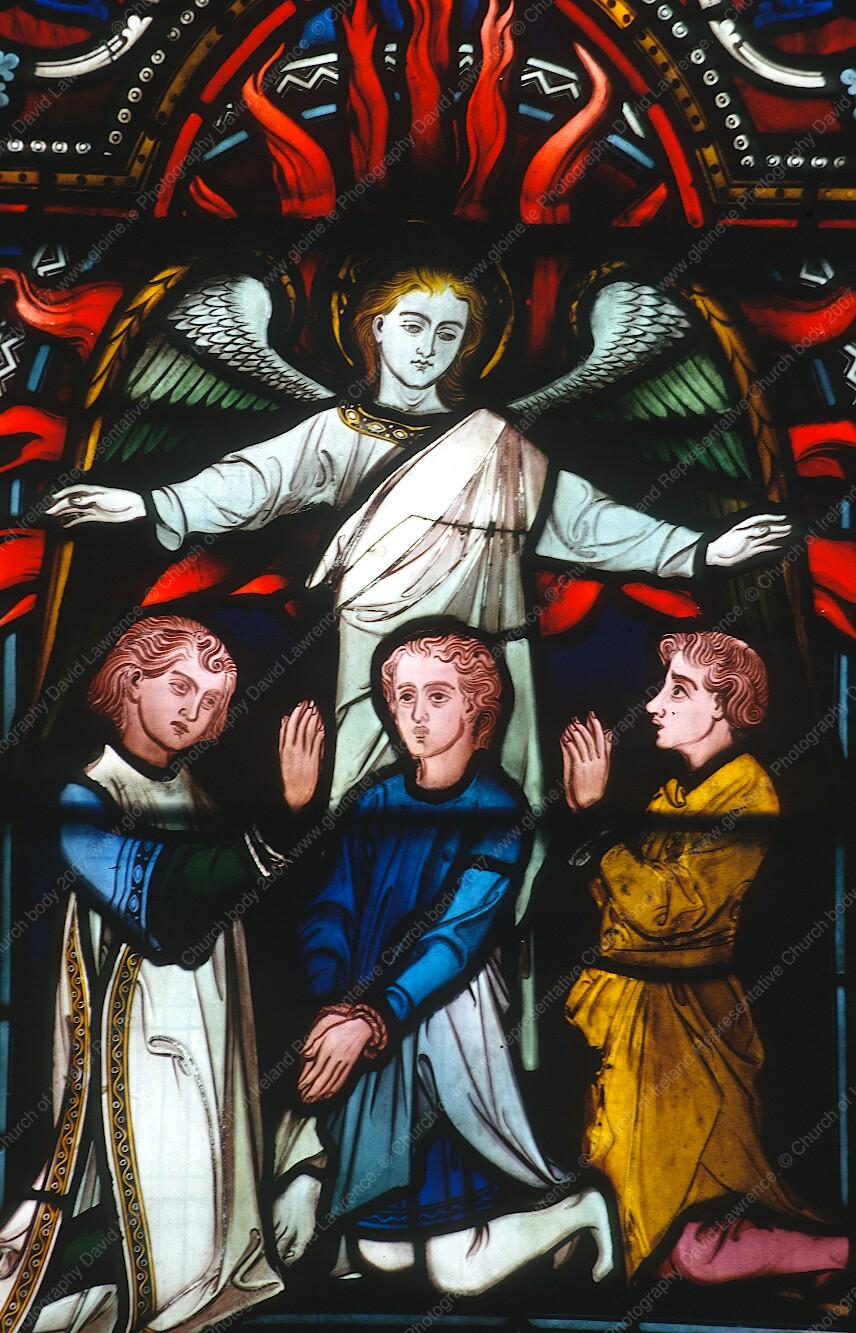
Strongbow(ストロングボウ)像。
この「磔刑とキリストの栄光」の構図は、内陣側面窓の伝統的配置テーマのひとつで、
祭壇背後(東端)ではなく側面に置かれる場合が多い と。

上段:
聖家族と訪問者(おそらく東方の三博士の一場面、または宮殿でのやり取り)
下段: 聖家族(マリア・幼子イエス・ヨセフ)への礼拝場面
新約聖書の降誕・幼年期の物語で、伝統的に南側の連続窓に配されるテーマ。
下段: 聖家族(マリア・幼子イエス・ヨセフ)への礼拝場面
新約聖書の降誕・幼年期の物語で、伝統的に南側の連続窓に配されるテーマ。

上段をズーム して。

これも身廊、南側通路、南、東から2番目
上段:
羊を担ぐ人物(「善き羊飼い」または羊飼いの召命の場面)
下段:
鍬や杖を持つ二人の人物(農耕や旅立ち、あるいは兄弟に関する寓話的場面)
これらは旧約的・寓話的テーマで、南側窓列の物語構成の一部。

これも身廊、南側通路、南、東から3番目
下段にオルガンや楽器を弾く人物(おそらく詩篇作曲者ダビデや聖セシリア)が描かれ、
南列の旧約音楽主題と一致。

中、下段をズームして。
中央の人物
白い長衣をまとい、座って鍵盤を弾く人物。聖書や伝統美術においては、 ユバル(Jubal)(創世記4:21)とされることが多い。
ユバルは旧約聖書で「竪琴と笛を奏でる者の祖」とされ、楽器製作や音楽の起源を象徴する と。
周囲の人物
背後に立つ2人:笛(またはシャルメ)と弦楽器を奏でる人物。
手前右下:オルガンの送風装置(ふいご)を操作する少年。
背景の白い鳩
鳩は聖霊や平和を象徴し、音楽が神聖な賛美であることを表す。

内陣南側(右側)の西寄り、聖人列(特に天使・守護聖人テーマ)の並びの中に。
上部の場面
・中央にひざまずく人物(罪人や異端者を象徴)を、両側から二人の人物が導いている構図。
・これは審判や救済の文脈に関連する場面で、下部の「悪を打ち負かす」ミカエルの場面と
対になっています。
対になっています。
下部の場面
・白い衣と緑のマントをまとい、剣を手にする有翼の人物が、赤い悪魔(または竜)を足元に
踏みつけています。
踏みつけています。
・剣を振り下ろす姿は、ヨハネの黙示録(黙示録12章)における「天の軍勢の長・ミカエルが
竜を倒す場面」に基づくもの。
竜を倒す場面」に基づくもの。
・下の円形飾りに「MICHAEL」の文字。

南面のステンドグラス案内図。
南側入口付近(南側通路の西端) にあるステンドグラス。
南側通路の最も西寄り、観光案内や掲示板が設置されているエリア上部に位置。

この窓のモチーフは、 上下2段構成で聖人像が描かれており 、南列の物語順には含まれず
独立した装飾的・記念的窓となっている と。

上段をズームして。
「ダニエル書」に描かれるダニエルが獅子の穴から救われる場面。
伏すライオンが描かれている。

下段をズームして。
火の炉の中の三人の若者(シャデラク、メシャク、アベド・ネゴ)と彼らを守る天使を描いている。
背景の炎と天使の翼が象徴的で、彼らが火の中でも無傷で守られた奇跡を表す。

Strongbow(ストロングボウ)像。
12世紀の ノルマン征服者リチャード・ド・クレア(Richard de Clare, 2nd Earl of Pembroke)
の墓を示すもの。
の墓を示すもの。
リチャード・ド・クレアは「Strongbow(強弓)」の通称で知られ、1170年のアイルランド侵攻で
大きな役割を果たしたノルマン騎士。
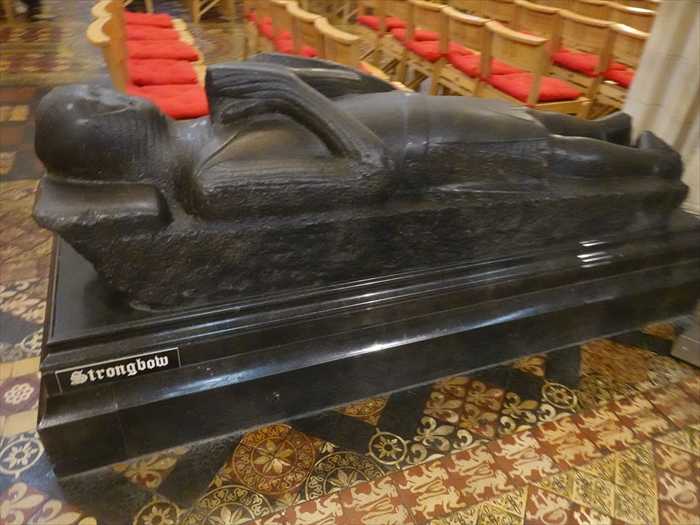
クリアストーリー(Clerestory)窓の一部を撮影。
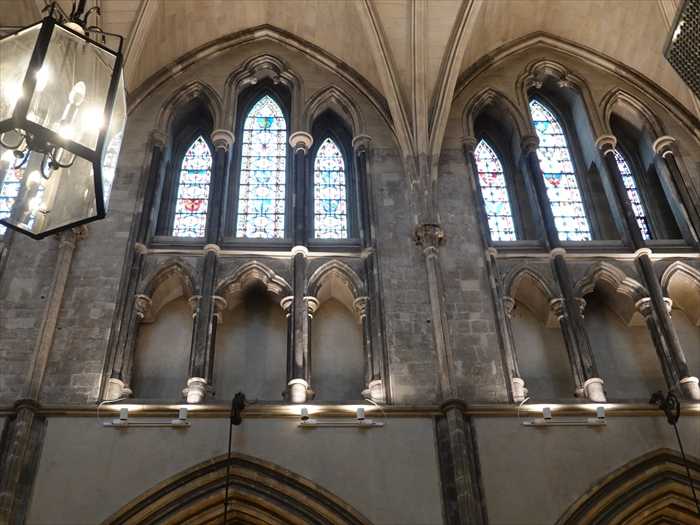
Christ Church Cathedral の身廊(Nave)から東(内陣方向)を望んだ全景。
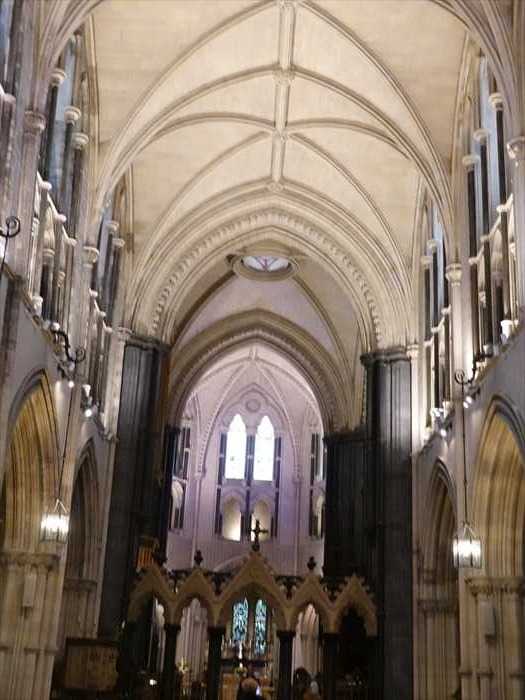
Christ Church Cathedral 東端・内陣(Chancel)正面の左右2連の大きなステンドグラス。
これは最も東の壁(East End)の中央高窓で、祭壇のすぐ背後にあります。
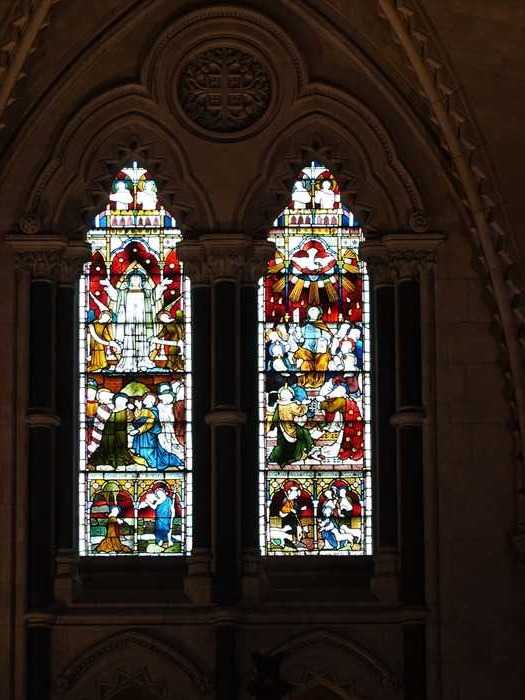
カテドラルの 司教座(Bishop’s Throne) 。

大司教座に掲げられたダブリンおよびグレンダロッホ教区の旗。

Christ Church Cathedral(ダブリン) 南側の出入口付近。

南側側廊(South Aisle)を東方向(内陣方向)から西に向けて。
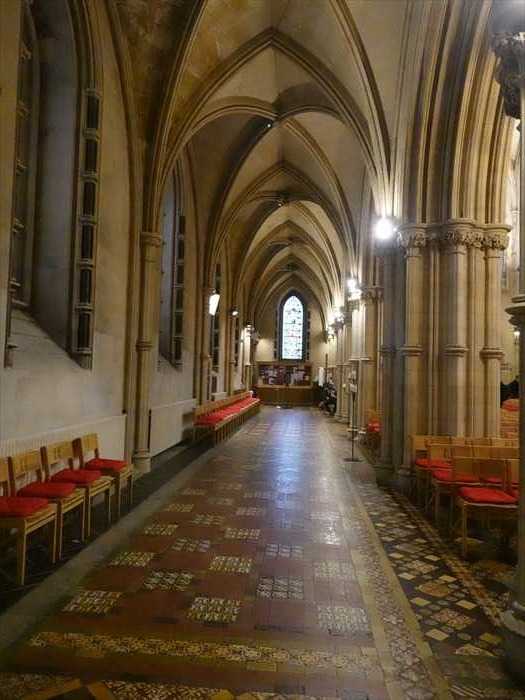
・西正面(West Front)から東方向(内陣方向)を見た全景 。
・西端の主入口付近から中央身廊(Nave)の中心軸に沿ってカメラを。
・上部に見える5連の尖頭アーチ窓が「西正面大窓(Great West Window)」で、外部からもよく
見える特徴的なファサード要素。

この大きなステンドグラスは、 5つの縦長のランセット窓(lancet windows) で構成されており、
それぞれに2〜3名の人物が描かれていた。
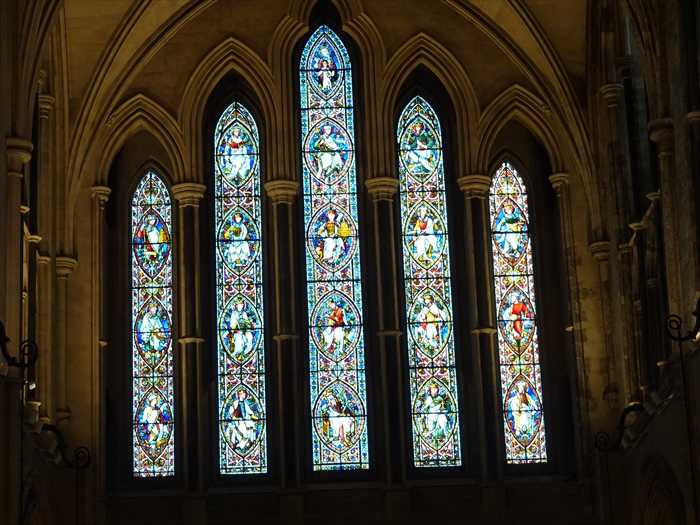
ズームして。

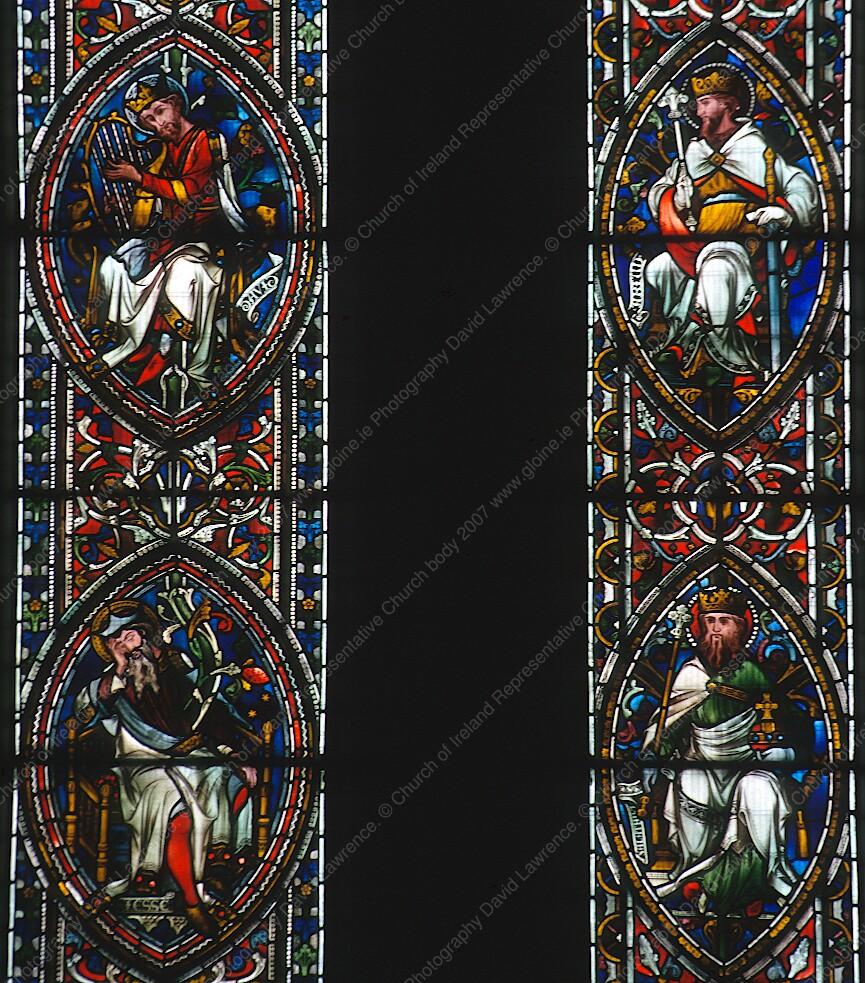
バラ窓(Rose Window) の一つで、キリスト教における象徴と徳(Virtues)を主題とした構成。

身廊から見て内陣・聖歌隊エリアへの境界部分、十字架交差部(tower crossing)の下部から。
天井中心には三位一体の盾紋、右手(北翼廊側)にはパイプオルガン。
前景の精緻なアーチ構造は、ヴィクトリア朝時代に設けられたスクリーン(choir screen)で、
これは内陣と身廊(Nave/Nave)を隔てる区切りとして機能。
これもまた、建築家G. E. Streetによる1875年の改修によるもの と。
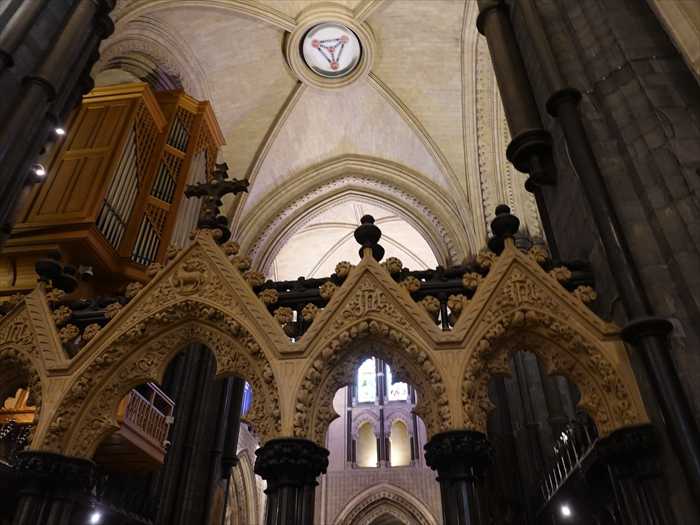
地下クリプト(Crypt)内にあった記念碑(墓碑)。
ロココ風の装飾(スクロールやアカンサスの葉)を持つ楯形カルトゥーシュ(楯形装飾枠)と、
両側に垂れ下がる花綱(ガーランド)が彫刻されていた。
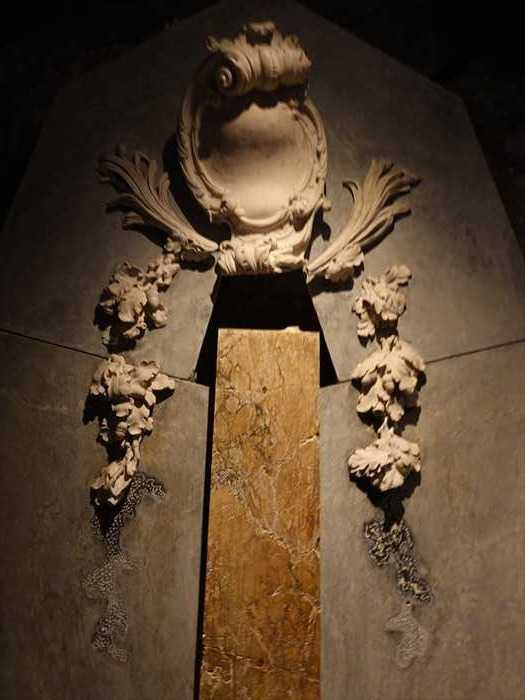
これが有名な Lord John Bowes(ジョン・ボウズ卿)記念碑。

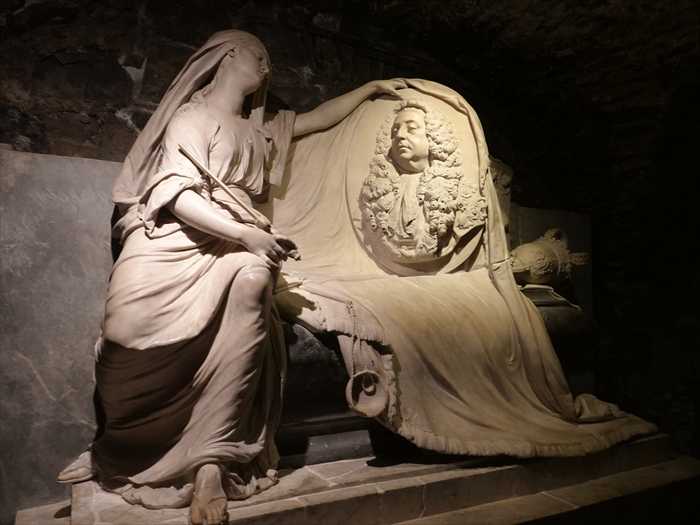
「Sacred
【ジョン・卿(ロード)・ボウズ
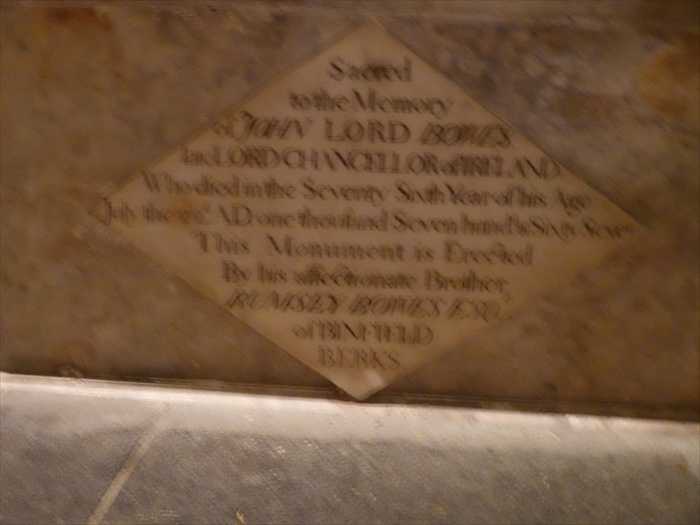
Lord John Bowes(ジョン・ボウズ卿)記念碑の奥・アーチ型の空間にも彫刻作品が。

奥にあったのが、 大きな石造のイングランド王室の紋章(Royal Coat of Arms)と、
それを両側で挟む二体の人物像 。


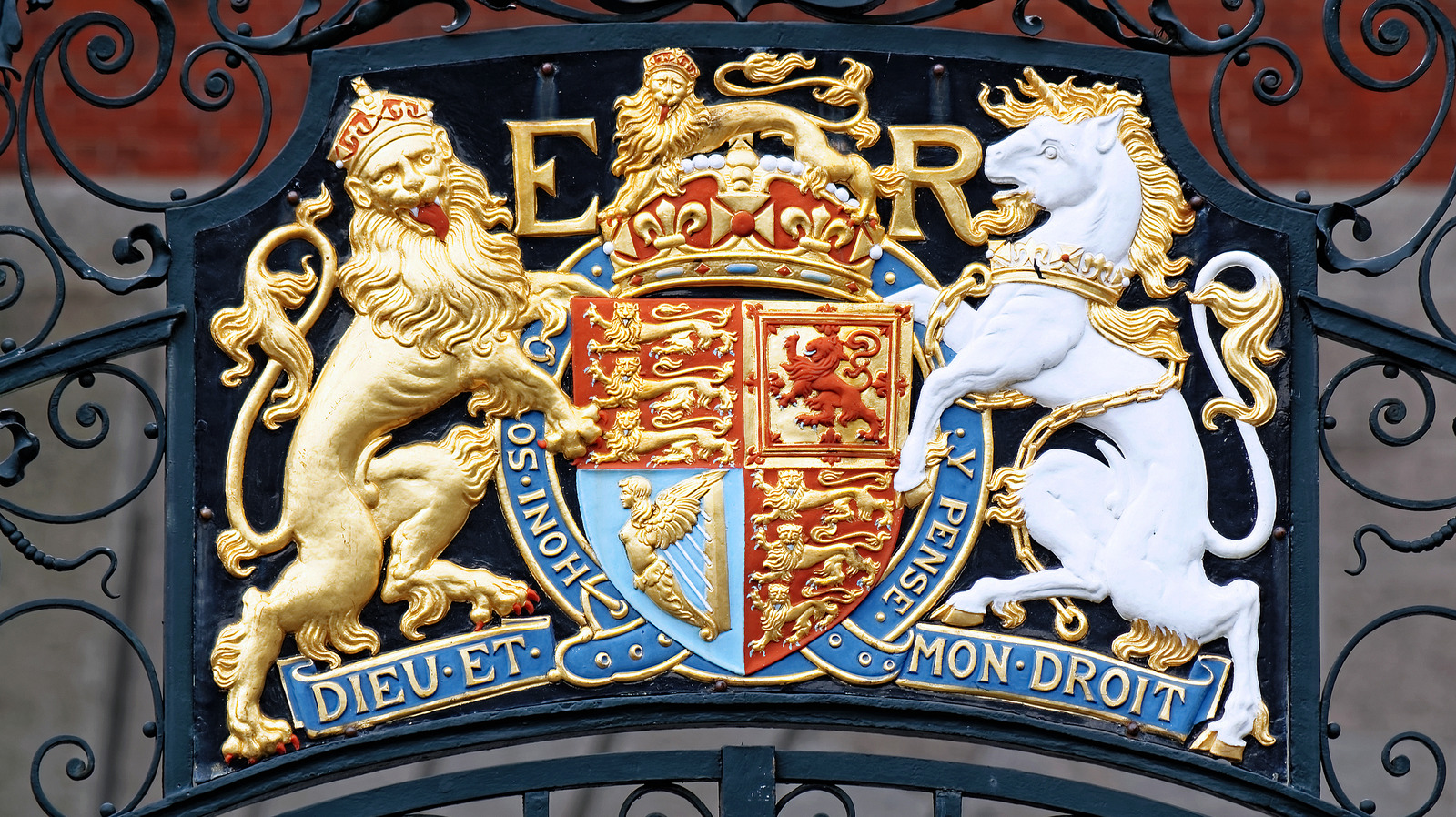
両側の人物像: 17世紀〜18世紀初頭の服装をまとった男性像で、王権を象徴する宮廷人物
または当時の権力者を表す と。
左の人物像

右の人物像

旧ダブリン市庁舎(Tholsel, Dublin)
を描いた19世紀以前の版画。
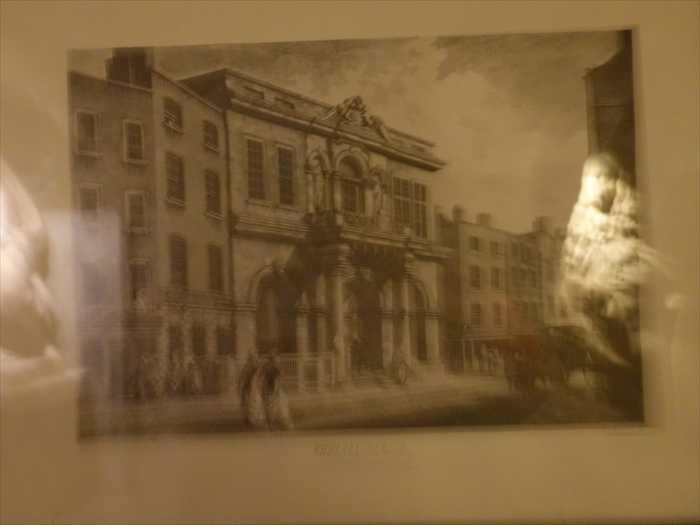
ネットから。

クリプト内部の一角で、 石造アーチが連続する通路部分 。
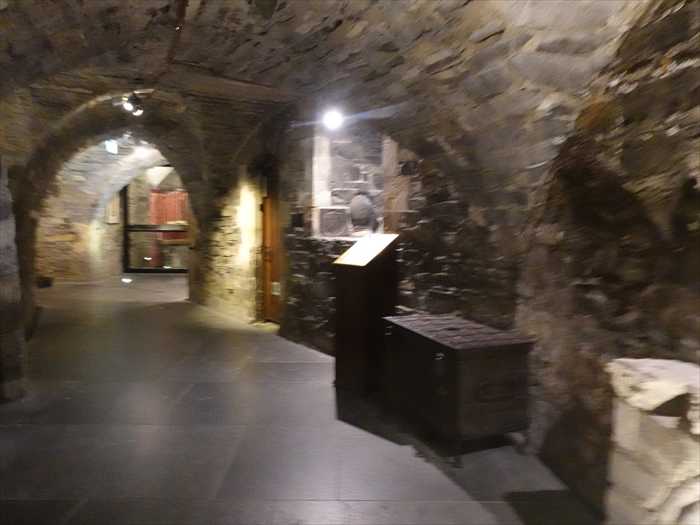
クリプト内にある小窓部分で、 外光を取り入れるための格子付き窓 。

「The Nuremberg Chest 」 。

「 Christ Church Cathedral
specifically mentioned in July 1688 when it was used to transport cathedral records to
safety in England. Later an entry in the proctor’s accounts refers to “bringing the said
chest and records home”.」
【 クライスト・チャーチ大聖堂
このとき、大聖堂の記録を安全のためイングランドへ運ぶのに使用されました。後年、プロクター
(財務係)の会計記録には「このチェストと記録を持ち帰った」と記されています。】
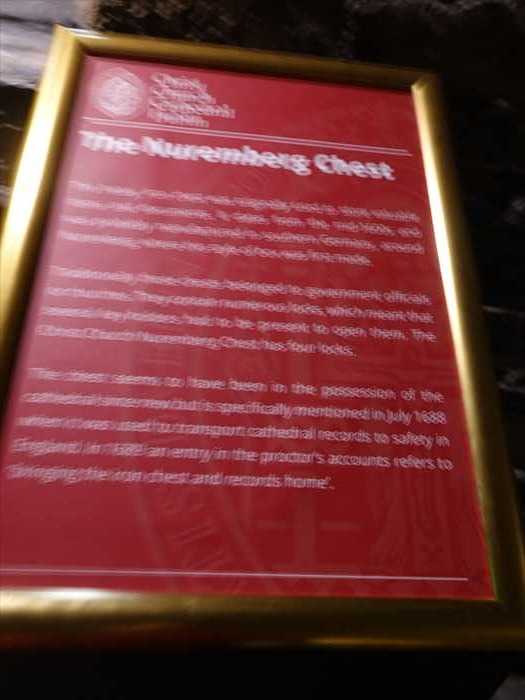
クリプト内に展示されている 金色の十字架付き装飾スタンド。
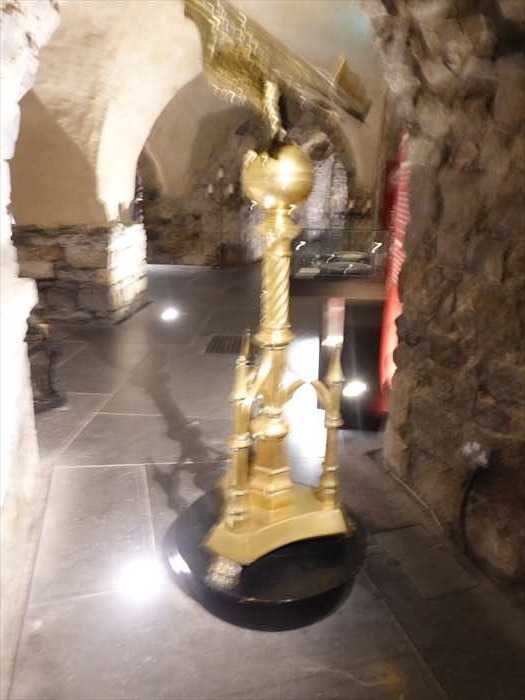
廻り込んで。
イーグル・リクターナ(Eagle Lectern) と呼ばれる、聖書を載せて朗読するための演台。

ネットから。

「 James II and Christ Church
bread and wine – used by Father Stafford during this mass can be seen in the case to
your left. Little did Father Stafford or James II know that the elaborate church plate
usually used was buried under a coffin beneath their feet.」
【ジェームズ2世とクライスト・チャーチ
ぶどう酒を保管するためのもの)は、左手の展示ケースで見ることができます。スタッフォード神父
もジェームズ2世も、その足元の棺の下に、通常使用される豪華な教会用食器が埋められている
ことを知る由もありませんでした。】

案内板に記載されていた ジェームズ2世(James II)とアレクシウス・スタッフォード神父 の
ミサ関連展示。

「 Treasures of Christ Church
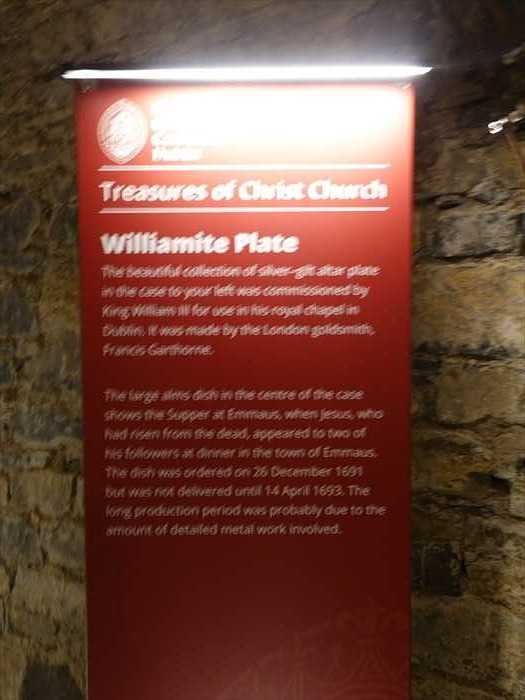
上記案内板で説明されていた ウィリアマイト・プレート(Williamite Plate)の現物展示 。
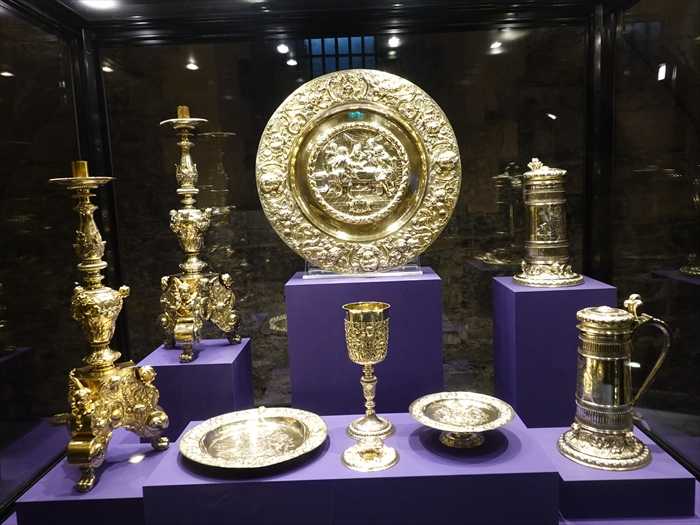
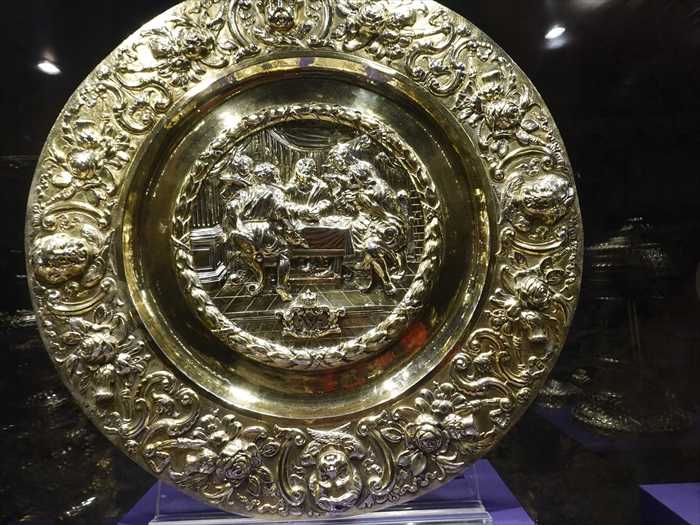
大型の燭台(candlestick)2基 。

蓋付きタンカード(covered tankard)とピッチャー 。

「 LISTENING BENCH(リスニング・ベンチ) 」はこちらと。

・・・もどる・・・
・・・つづく・・・
大きな役割を果たしたノルマン騎士。

クリアストーリー(Clerestory)窓の一部を撮影。
南側廊(South Aisle)上方、主身廊(Nave)との境界壁上部にあたります。
下段の尖頭アーチ部分は装飾的なトリフォリウム(Triforium)で、実際には通路ではなく
装飾壁面。
この窓は物語場面ではなく、幾何学的パターンや色ガラスを主体とした意匠で、南列の下段に並ぶ
物語パネルとは異なる系統の装飾が。
装飾壁面。
この窓は物語場面ではなく、幾何学的パターンや色ガラスを主体とした意匠で、南列の下段に並ぶ
物語パネルとは異なる系統の装飾が。

Christ Church Cathedral の身廊(Nave)から東(内陣方向)を望んだ全景。

Christ Church Cathedral 東端・内陣(Chancel)正面の左右2連の大きなステンドグラス。
これは最も東の壁(East End)の中央高窓で、祭壇のすぐ背後にあります。
位置
先ほどの内観写真(身廊から東方向を見た写真)の最奥に見えていた窓がこれです。
構造
・二連の尖頭アーチ窓(左・右)
・各窓は上下3段の物語パネルで構成
・上部に小円窓(ラウンドの石細工装飾)があり、その下に2連窓が並ぶ
主題(推測)
光の強弱や構図から推測すると、
・左列:キリストの復活、聖母マリア、受胎告知など
・右列:聖霊降臨、東方三博士礼拝、幼少期のキリストの場面
といった新約聖書の主要場面が並んでいた。

カテドラルの 司教座(Bishop’s Throne) 。
・中央の椅子
ゴシック様式の高い背もたれと尖塔状の飾りを持つ木製の椅子は、ダブリン大司教の公式座席
(Cathedra)です。大聖堂が「Cathedral」と呼ばれるのは、この司教座が置かれているためです。
(Cathedra)です。大聖堂が「Cathedral」と呼ばれるのは、この司教座が置かれているためです。
・垂れ布(バナー)
背後に掛けられているバナーには、青地に銀の逆Y字(パラル形)と5つの黒い十字が
描かれています。これはダブリン大司教区の紋章で、アイルランド聖公会(Church of Ireland)に
属します。
描かれています。これはダブリン大司教区の紋章で、アイルランド聖公会(Church of Ireland)に
属します。
・位置
司教座は通常、内陣(Chancel)の南側に置かれ、聖職者席(choir stalls)の一部として
組み込まれています。この写真の背景にも、内陣南側のステンドグラスやパネルがわずかに
見えます。
組み込まれています。この写真の背景にも、内陣南側のステンドグラスやパネルがわずかに
見えます。

大司教座に掲げられたダブリンおよびグレンダロッホ教区の旗。

Christ Church Cathedral(ダブリン) 南側の出入口付近。
場所
このドアは南廊(South Transept)に近い位置、つまり南壁にあり、外部に直接出られる扉。
訪問者の入退場口や緊急出口としても使われていた。
訪問者の入退場口や緊急出口としても使われていた。
上部のステンドグラス
アーチ上部には小型の縦長ステンドグラスが1枚あり、彩色は赤・青が目立った。

南側側廊(South Aisle)を東方向(内陣方向)から西に向けて。
・右奥の明るい部分は南側の西端(南玄関)方向。
・左に見える細長い縦窓は、外壁上部に並ぶ高窓(クリアストーリー窓)で、下部は
ベンチが設置された壁面。
・奥(西端)の壁中央に縦長のステンドグラスが1枚。
この窓は「南西端窓(West end of South Aisle)」にあたる。
・色タイルによる幾何学模様が中央に伸び、左右に石列・ベンチが並んでいた。
・天井は、交差リブ・ヴォールトが側廊の全長にわたって連続していた。
・左に見える細長い縦窓は、外壁上部に並ぶ高窓(クリアストーリー窓)で、下部は
ベンチが設置された壁面。
・奥(西端)の壁中央に縦長のステンドグラスが1枚。
この窓は「南西端窓(West end of South Aisle)」にあたる。
・色タイルによる幾何学模様が中央に伸び、左右に石列・ベンチが並んでいた。
・天井は、交差リブ・ヴォールトが側廊の全長にわたって連続していた。

・西正面(West Front)から東方向(内陣方向)を見た全景 。
・西端の主入口付近から中央身廊(Nave)の中心軸に沿ってカメラを。
・上部に見える5連の尖頭アーチ窓が「西正面大窓(Great West Window)」で、外部からもよく
見える特徴的なファサード要素。

この大きなステンドグラスは、 5つの縦長のランセット窓(lancet windows) で構成されており、
それぞれに2〜3名の人物が描かれていた。
主題:旧約・新約の預言者や使徒、聖人たち
中央列上部にはキリスト(または聖母マリア)が玉座に座している姿が。
それを囲むように旧約の預言者、福音記者、使徒などが楽器、書物、巻物などの象徴を持って
描かれていた。
描かれていた。

ズームして。

左上
DAVIDダビデ王
。
赤いローブに 王冠をかぶり、ハープ(リラ)を奏でる姿。詩篇作者として有名で、キリストの
家系の祖先。
赤いローブに 王冠をかぶり、ハープ(リラ)を奏でる姿。詩篇作者として有名で、キリストの
家系の祖先。
左下 JESSEエッサイ(イザイ)。
ダビデ王の父。系図の起点として描かれ、「エッサイの根」はキリストの系譜を象徴する。
花を持っており、「エッサイの木」への示唆。
ダビデ王の父。系図の起点として描かれ、「エッサイの根」はキリストの系譜を象徴する。
花を持っており、「エッサイの木」への示唆。
右上SOLOMONソロモン王。
ダビデの息子。知恵の王として知られ、杖と書物を持って描かれることが多い。
ここでは王笏と巻物を所持。
ダビデの息子。知恵の王として知られ、杖と書物を持って描かれることが多い。
ここでは王笏と巻物を所持。
右下REHOBOAM(レハブアム)
ソロモンの子で、ユダ王国の初代王。王笏と巻物を手にし、王権の継承を象徴している。
ソロモンの子で、ユダ王国の初代王。王笏と巻物を手にし、王権の継承を象徴している。

バラ窓(Rose Window) の一つで、キリスト教における象徴と徳(Virtues)を主題とした構成。
【 中央の円
】
・ 人物:キリスト
(おそらく「善き羊飼い(The Good Shepherd)」)
・ 持ち物:羊飼いの杖(牧者の象徴)、周囲に2匹の羊
・背景の語句:
・赤字で「LOVE」(愛)
・縁取りに「JOY(喜び)」「PEACE(平和)」「LONGSUFFERING(寛容)」などの文字
・象徴:聖霊の実(Fruits of the Spirit) を象徴する。これは新約聖書・ガラテヤ人への
手紙5:22–23 に基づく。
手紙5:22–23 に基づく。

身廊から見て内陣・聖歌隊エリアへの境界部分、十字架交差部(tower crossing)の下部から。
天井中心には三位一体の盾紋、右手(北翼廊側)にはパイプオルガン。
前景の精緻なアーチ構造は、ヴィクトリア朝時代に設けられたスクリーン(choir screen)で、
これは内陣と身廊(Nave/Nave)を隔てる区切りとして機能。
これもまた、建築家G. E. Streetによる1875年の改修によるもの と。

地下クリプト(Crypt)内にあった記念碑(墓碑)。
ロココ風の装飾(スクロールやアカンサスの葉)を持つ楯形カルトゥーシュ(楯形装飾枠)と、
両側に垂れ下がる花綱(ガーランド)が彫刻されていた。

これが有名な Lord John Bowes(ジョン・ボウズ卿)記念碑。
・場所:
大聖堂地下クリプトの南側通路(南壁側)に設置。
・人物:ジョン・ボウズ卿(†1767)はアイルランドの大法官(Lord Chancellor of Ireland)
を
務めた人物。
務めた人物。
・造形:大理石彫刻で、ローブをかけた女性像(悲嘆を象徴する「グリーフ(Grief)」の擬人化像)
が棺の上に座り、片手で布を持ち上げています。背後のレリーフには盾形紋章や
戦勝記念のトロフィー、右側には倒れた壺(生命の終わりの象徴) 。
が棺の上に座り、片手で布を持ち上げています。背後のレリーフには盾形紋章や
戦勝記念のトロフィー、右側には倒れた壺(生命の終わりの象徴) 。
・製作時期:
1767年の没後、18世紀後半に制作。
・作風:
新古典主義の影響を受けたロココ的ディテールで、当時の葬礼彫刻に典型的な構図。

・像の構成:
・左側の女性像は、悲嘆(Grief)または信仰(Faith)の擬人化。ヴェールを被り、片手で棺を
覆う布を持ち上げています。
覆う布を持ち上げています。
・布の下から現れるのはジョン・ボウズ卿の浮き彫り肖像(典型的な18世紀の法服と巻き毛の
かつら)。
かつら)。
・背後には紋章やトロフィーが彫刻され、右奥には倒れた壺(生命の終わりの象徴)が見えます。
・ 被葬者:John Bowes, 1st Baron Bowes(1691–1767)
・アイルランド大法官(Lord Chancellor of Ireland)を務めた法曹界の重鎮。
・1767年没後、この記念碑がクリプト南壁側に設置された。

「Sacred
to the Memory
of JOHN LORD BOWES
late LORD CHANCELLOR OF IRELAND
Who died in the Seventy Sixth Year of his Age
July the 22nd One thousand Seven hundred Sixty Seven
This Monument is Erected
By his affectionate Brother
RUMSEY BOWES Esq.
of BINFIELD
BERKS」 【ジョン・卿(ロード)・ボウズ
前アイルランド大法官
の思い出に捧ぐ。
彼は享年76歳にして
1767年7月22日に逝去した。
この記念碑は、
彼を愛する弟
ラムジー・ボウズ(エスクワイア)
バークシャー州ビンフィールドの人
によって建立された。】
Lord John Bowes(ジョン・ボウズ卿)記念碑の奥・アーチ型の空間にも彫刻作品が。

奥にあったのが、 大きな石造のイングランド王室の紋章(Royal Coat of Arms)と、
それを両側で挟む二体の人物像 。

盾形紋章を掲げるライオンとユニコーン(イングランド王家の伝統的な紋章保持者)
。
盾の中にはイングランド、スコットランド、アイルランドの紋章が四分割で配置されていた
形跡 が。
盾の中にはイングランド、スコットランド、アイルランドの紋章が四分割で配置されていた
形跡 が。
下部リボンにはモットー" DIEU ET MON DROIT
"(フランス語:「神と我が権利」)が
刻まれていた。これはイングランド王室の公式標語 と。
刻まれていた。これはイングランド王室の公式標語 と。


両側の人物像: 17世紀〜18世紀初頭の服装をまとった男性像で、王権を象徴する宮廷人物
または当時の権力者を表す と。
左の人物像

右の人物像


ネットから。
クリプト内部の一角で、 石造アーチが連続する通路部分 。
・写真中央やや右にある木製案内パネルと大型金属製チェスト(献金箱または保管箱)は、
クリプトの南側通路西寄りに置かれている展示物と一致します。
クリプトの南側通路西寄りに置かれている展示物と一致します。
・さらに奥に見えるガラスケース内の赤い布の展示は、クリプト内の宝物展示コーナー
(Treasures of Christ Church)の一部。
(Treasures of Christ Church)の一部。
・天井は中世以来の石造ヴォールト(半円形アーチ)、床は近年改修された石板敷き。

クリプト内にある小窓部分で、 外光を取り入れるための格子付き窓 。
・構造:
厚い石壁に穿たれた縦長の開口部で、外側に鉄製の格子が設置されていた。
・用途:
クリプトは地下にありながらも完全な密閉ではなく、こうした小窓で通風と採光を
確保していた。
確保していた。

「The Nuremberg Chest 」 。

「 Christ Church Cathedral
The Nuremberg Chest
The Nuremberg Chest is a large iron-bound chest, which probably came from Nuremberg, Germany, in the 1680s, and was used to store important cathedral documents.
Traditionally, such chests belonged to government officials and were fitted with three or
more locks, which meant that several key-holders had to be present to open them.
The Christ Church Nuremberg Chest has four locks.
The chest seems to have been in the possession of the cathedral since new, but ismore locks, which meant that several key-holders had to be present to open them.
The Christ Church Nuremberg Chest has four locks.
specifically mentioned in July 1688 when it was used to transport cathedral records to
safety in England. Later an entry in the proctor’s accounts refers to “bringing the said
chest and records home”.」
【 クライスト・チャーチ大聖堂
ニュルンベルクのチェスト(Nuremberg Chest)
この「ニュルンベルクのチェスト」は、大型の鉄で補強された木製の箱で、1680年代に
ドイツのニュルンベルクからもたらされた可能性が高く、大聖堂の重要な文書を保管するために
使われました。
ドイツのニュルンベルクからもたらされた可能性が高く、大聖堂の重要な文書を保管するために
使われました。
伝統的に、この種のチェストは政府役人が所有し、3つ以上の錠前を備えていました。
複数の鍵を持つ人物が同時に立ち会わなければ開けられない仕組みです。
クライスト・チャーチのニュルンベルク・チェストには4つの錠前があります。
このチェストは新造時から大聖堂が所有していたようですが、特に1688年7月の記録に登場します。複数の鍵を持つ人物が同時に立ち会わなければ開けられない仕組みです。
クライスト・チャーチのニュルンベルク・チェストには4つの錠前があります。
このとき、大聖堂の記録を安全のためイングランドへ運ぶのに使用されました。後年、プロクター
(財務係)の会計記録には「このチェストと記録を持ち帰った」と記されています。】

クリプト内に展示されている 金色の十字架付き装飾スタンド。

廻り込んで。
イーグル・リクターナ(Eagle Lectern) と呼ばれる、聖書を載せて朗読するための演台。
・鷲の背に広げた聖書を置き、鷲が神の言葉を世界に運ぶ象徴的意味を持ちます。
・金色(真鍮または鍍金)で作られており、儀式用具として非常に格式の高いもの。

ネットから。

「 James II and Christ Church
Christ Church is an Anglican cathedral and has been since the dissolution of the Priory of
the Holy Trinity in 1541.
the Holy Trinity in 1541.
However, for a brief time in 1689–90 the cathedral reverted to Roman Catholicism under
the reign of King James II. Father Alexius Stafford, one of James’s private chaplains,
celebrated Mass here for him in 1689 when James came to Ireland to try and recover
his kingdoms.
The plain brass candlesticks and the wooden tabernacle – for keeping the consecratedthe reign of King James II. Father Alexius Stafford, one of James’s private chaplains,
celebrated Mass here for him in 1689 when James came to Ireland to try and recover
his kingdoms.
bread and wine – used by Father Stafford during this mass can be seen in the case to
your left. Little did Father Stafford or James II know that the elaborate church plate
usually used was buried under a coffin beneath their feet.」
【ジェームズ2世とクライスト・チャーチ
クライスト・チャーチは英国国教会(アングリカン)の大聖堂であり、1541年に聖三位一体修道院(Priory of the Holy Trinity)が解散して以来、その地位を保っています。
しかし、1689年から1690年にかけての短期間、ジェームズ2世の治世下で、この大聖堂は一時的に
ローマ・カトリックに戻りました。ジェームズの侍祭の一人であるアレクシウス・スタッフォード
神父は、1689年にジェームズが自らの王国を取り戻すためアイルランドに来た際、ここで彼の
ためにミサを執り行いました。
このミサの際、スタッフォード神父が使用した真鍮の燭台と木製の聖櫃(聖別されたパンとローマ・カトリックに戻りました。ジェームズの侍祭の一人であるアレクシウス・スタッフォード
神父は、1689年にジェームズが自らの王国を取り戻すためアイルランドに来た際、ここで彼の
ためにミサを執り行いました。
ぶどう酒を保管するためのもの)は、左手の展示ケースで見ることができます。スタッフォード神父
もジェームズ2世も、その足元の棺の下に、通常使用される豪華な教会用食器が埋められている
ことを知る由もありませんでした。】

案内板に記載されていた ジェームズ2世(James II)とアレクシウス・スタッフォード神父 の
ミサ関連展示。
展示内容
・中央:木製の聖櫃(tabernacle)
・聖別されたパン(聖体)やワイン(聖血)を保管するための祭具。
・ドーム型の上部構造とアーチ型の入口があり、金箔や彩色の装飾が残っています。
・1689年にスタッフォード神父がジェームズ2世のために行ったミサで使用されたものとされます。
・左:
聖書または典礼書(ゴールドの布表紙)
・中央前面
:金製の聖杯(chalice)
・右:
真鍮製の燭台(plain brass candlestick)
・右奥:
平らな銀皿(教会用食器の一部)

「 Treasures of Christ Church
Williamite Plate
The beautiful collection of silver-gilt altar plate in the case to your left was commissioned
by King William III for use in his royal chapel in Dublin. It was made by the London
goldsmith, Francis Garthorne.
by King William III for use in his royal chapel in Dublin. It was made by the London
goldsmith, Francis Garthorne.
The large alms dish in the centre of the case shows the Supper at Emmaus, when Jesus,
who had risen from the dead, appeared to two of his followers at dinner in the town of
Emmaus.
who had risen from the dead, appeared to two of his followers at dinner in the town of
Emmaus.
The dish was ordered on 26 December 1693 but was not delivered until 14 April 1695.
The long production period was probably due to the amount of detailed metal work
involved.」
【 クライスト・チャーチの宝物
The long production period was probably due to the amount of detailed metal work
involved.」
【 クライスト・チャーチの宝物
ウィリアマイト・プレート(Williamite Plate)
左手の展示ケースにある、美しい金メッキ銀製の祭壇用食器セットは、ダブリンにある
王室礼拝堂で使用するために、ウィリアム3世によって注文されたものです。製作はロンドンの
金細工師フランシス・ガースホーンによるものです。
王室礼拝堂で使用するために、ウィリアム3世によって注文されたものです。製作はロンドンの
金細工師フランシス・ガースホーンによるものです。
ケース中央に展示されている大型の施し皿(アームズ・ディッシュ)には、復活したイエスが
エマオの町で2人の弟子に夕食の席で現れた「エマオでの晩餐」の場面が描かれています。
エマオの町で2人の弟子に夕食の席で現れた「エマオでの晩餐」の場面が描かれています。
この皿は1693年12月26日に発注されましたが、納品されたのは1695年4月14日でした。
この長い製作期間は、非常に精緻な金属細工作業が必要だったためと考えられます。】
この長い製作期間は、非常に精緻な金属細工作業が必要だったためと考えられます。】

上記案内板で説明されていた ウィリアマイト・プレート(Williamite Plate)の現物展示 。
内容と特徴
・中央上段:
・中央上段:
・大型の施し皿(alms dish)
・中央には「エマオでの晩餐」の場面が精緻なレリーフで描かれています。
・周囲はアカンサス文様などのバロック風装飾で縁取られています。
左右上段:
・大型の燭台(candlestick)2基(左側)
・蓋付きタンカード(covered tankard)とピッチャー(右側)
下段中央:
・金製聖杯(chalice)
・小型皿(patens または小施し皿)2枚
製作背景
・製作者:ロンドンの金細工師 フランシス・ガースホーン(Francis Garthorne)
・年代:1693年発注、1695年納品
・発注者:イングランド国王ウィリアム3世(William III)
・用途:ダブリンの王室礼拝堂での祭儀用

中央上段:
・大型の施し皿(alms dish)
・中央には「エマオでの晩餐」の場面が精緻なレリーフで描かれています。
・周囲はアカンサス文様などのバロック風装飾で縁取られています。

大型の燭台(candlestick)2基 。

蓋付きタンカード(covered tankard)とピッチャー 。

「 LISTENING BENCH(リスニング・ベンチ) 」はこちらと。
・体験型展示の一部で、ベンチに座ってイヤホンやスピーカーから流れる解説や物語を聞くことが
できるスポット。
できるスポット。
・内容は大聖堂の歴史や著名な出来事、埋葬者の物語、建築に関する説明など多岐にわたる と。

・・・もどる・・・
・・・つづく・・・
お気に入りの記事を「いいね!」で応援しよう
【毎日開催】
15記事にいいね!で1ポイント
10秒滞在
いいね!
--
/
--
© Rakuten Group, Inc.










